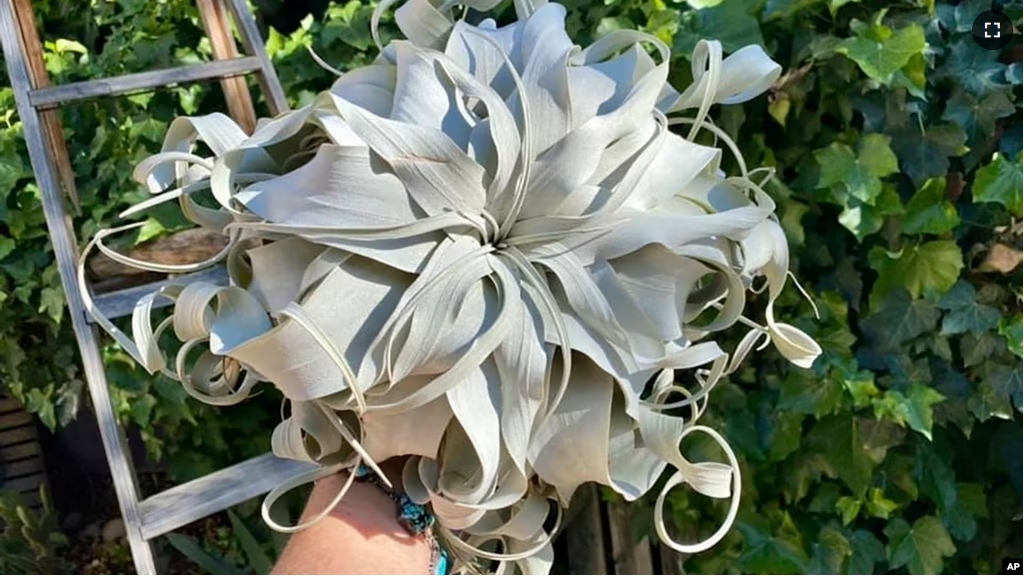If you are looking for houseplants that do not take up a lot of space and are easy to grow, air plants might be the right choice.
There are more than 500 different species of air plants. Officially they are known as Tillandsia. These plants are native to places in North and South America that support year-round plant growth. Air plants belong to the same family as the pineapple.
Instead of soil, these plants attach themselves to things like trees, rocks and buildings. They do not cause problems for the objects they grow on. Air plants do not have roots. They depend on specialized cells – called trichomes – to permit their leaves to take in water and nutrients.
Associated Press gardening writer Jessica Damiano has experimented with air plants and offers these guidelines for people wanting to grow them.

Sunlight
Air plants require bright, indirect light. So, they should be placed near an east- or west-facing window, but not directly in front of it. Direct sunlight can burn the plant’s leaves.
Watering
In homes with average humidity levels, put air plants in a bowl of room-temperature water once a week for 30 to 60 minutes. In homes with drier air, this process can be repeated when needed.
Lightly shake the plants to remove extra water. Then, place them upside-down on a cloth to dry for several hours. This step is necessary to prevent water from collecting on the plant’s leaves, which can cause damage.
If using chlorinated water, it is best to let the liquid sit for 12 to 24 hours to permit the chemical to dissipate before watering plants. Air plants are especially sensitive to chlorine.
Feeding the plants
Growers should feed their air plants with any all-purpose houseplant, bromeliad or orchid fertilizer. The substance should be added to the soaking water monthly to provide added nutrients. Use about half the amount suggested by the fertilizer manufacturer.

Life cycle
Air plants bloom only once. The resulting pink, coral, purple or white flowers are a signal that the plants are nearing death. However, air plants produce offshoots, known as “pups.” These can be separated into new plants once they grow to about one-third the size of the parent.
So many choices
Notable air plants include Spanish moss which can be found hanging from large trees in tropical or subtropical areas. In the home, Spanish moss is grown in a humid environment, such as a bathroom.
Another kind is Tillandsia ionantha, which is also known as the sky plant. It is a shaggy-looking plant with green bracts. Bracts are leaf-like structures that grow from the area just beneath a flower. The tops of bracts can turn pink or purple before flowering.
Tillandsia caput-medusae is named for its similarity to the snake-haired head of Medusa, from Greek mythology. The plant is popular because of its long, wavy leaves that grow upward from a fat, round base.
Perhaps the most unusual species of Tillandsia is the Xerographic air plant. This kind is known as the King of Air Plants. It can grow up to about one-half meter. The plant’s long, thin silver leaves curl downward to produce a round shape that sets it apart from other air plants.

How to show your Tillandsia
You can place air plants in just about any spot that provides the required sunlight and good air flow.
Glass containers or terrariums are popular choices. But growers can also put air plants inside seashells or on rocks. One could even create a floating Tillandsia garden by hanging several plants from fishing line.
The plants can also be attached to natural wood pieces with wire or glue. Some choose to grow them inside hanging frames. When choosing placement possibilities, the main thing to keep in mind is to make sure you are fully meeting all the plant’s needs.
I’m Bryan Lynn.
The Associated Press reported this story. Bryan Lynn adapted the report for VOA Learning English.
______________________________________
Words in This Story
species – n. a group of animals or plants that are similar and can produce young animals or plants
humidity – n. a measurement of how much water is in the air
dissipate –v. to dry up, disappear through evaporation or by becoming less and less dense
bloom – v. when a flower fully opens
shaggy – adj. having or covered with long, rough and messy hair
curl – v. when something moves in a circular direction
terrarium – n. a container, often made of glass, that is used to keep small plants in
frame – n. a border that surrounds and supports a picture, door or window
